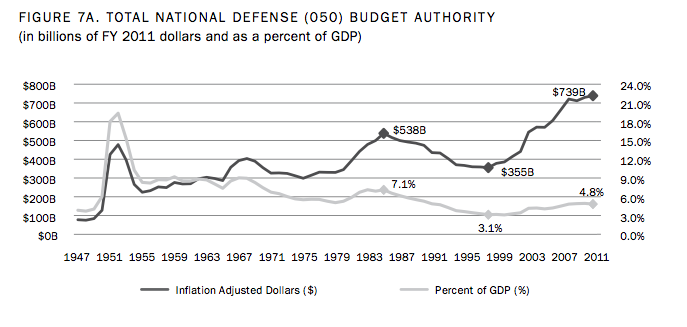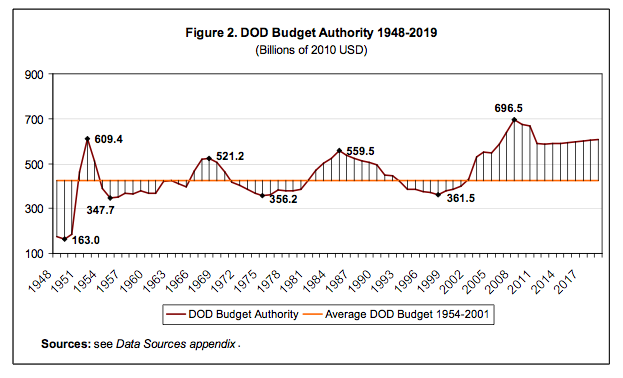There’s a call for increased defense spending in this morning’s Wall Street Journal opinion pages. Just as a thunderclap follows lightning, there will soon be a call for more cuts in military spending from the editorial page of the New York Times. There’s no reason you can’t play along with this game at home. To help, here’s a pair of charts so you can make your case, regardless of which side you embrace.

Center for Strategic and Budgetary Assessments
If you want to increase military spending, memorize the chart above. It shows, in the lighter gray line, how the share of the nation’s gross domestic product earmarked for the military has shrunk over the years. “Even with the costs of Iraq and Afghanistan, this year the Department of Defense will spend some $720 billion—about 4.9% of our gross domestic product, significantly below the average of 6.5% since World War II,” says a hat-trick of heavy hitters from the American Enterprise Institute, the Heritage Foundation, and the Foreign Policy Initiative, in today’s Journal. “We have not done enough to help our military preserve the peace and deter (and if necessary, defeat) our enemies.” (Pay no attention, as the Wizard of Oz himself might say, to the darker line that shows military spending doubling since 9/11, not including inflation).

Project on Defense Alternatives
If you think the nation is spending enough on its military, commit this graph to memory. It shows how much more we are spending today than we did during the Cold War. “Since the 9/11 attacks, Congress has given the Pentagon pretty much everything it has requested, with few questions asked,” the Times’ editorial page declared in August. “The military budget is 20 percent of federal spending and 50 percent of discretionary spending. There is no way to address the deficit without deeper cuts in defense spending.”
A couple of things to keep in mind:
— For those who embrace the top chart, why the amount of money we spend on defense should be viewed as a slice of GDP befuddles some national-security experts. Let’s spend based on the threat, they say, and not peg our military budget to something like the size of the nation’s economic pie, which has nothing to do with the threats we face (there has been a push in recent years to set the defense budget somewhere between 4 and 5 percent of GDP, kind of like a fiscal military thermostat).
— For those who prefer the bottom chart: hey, the Cold War was serious business, against an “evil empire” that could obliterate most of our nation in 30 minutes. Sure, the Soviet Union has been consigned to the “ash heap of history,” but China, Iran, North Korea and al Qaeda, taken together, are a much more potent threat to our nation than Moscow ever was, and worth the extra money we’re now spending on our military.


